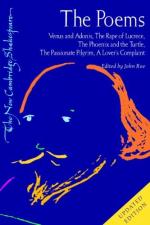|
This section contains 5,755 words (approx. 20 pages at 300 words per page) |

|
SOURCE: "'Neither Two Nor One': Dual Unity in 'The Phoenix and Turtle,'" in The Undiscover'd Country: New Essays on Psychoanalysis and Shakespeare, edited by B. J. Sokol, Free Association Books, 1993, pp. 39-56.
In the essay that follows, Bock contends that The Phoenix and Turtle, like Hamlet, explores a form of unity within which each element retains its identity.
Written at about the same time as Hamlet, Shakespeare's brief poem, The Phoenix and Turtle, bears little superficial resemblance to his longest play.1 Yet condensed into its 67 lines one finds a number of dynamic elements that may have been displaced from the author's awareness while he was writing the tragedy. The Phoenix and Turtle depicts a paradoxical dual unity that, I shall argue, can best be understood as representing the early 'normal symbiosis' between mother and child. This developmental phase is nostalgically commemorated (it has been lost), and it...
|
This section contains 5,755 words (approx. 20 pages at 300 words per page) |

|


